#mandalorian culture is pretty dynamic one when it comes to changes and evolutions or rather revolutions
Explore tagged Tumblr posts
Text
Cienie’s take on Mandalorian Culture: Kad Ha’rangir and mandalorian traditional weapons, p. 5
part 1 — part 2 — part 3 -- part 4
Caution: I have never personally played The Old Republic MMORPG game and all my knowledge about Mandalorians of that era comes from tie-in material including those published on dedicated to SWTOR sites and watching playthrough videos, especially of the last patch, Legacy of the Sith. Keeping that in mind, let’s wrap up the final part.
The Old Republic MMORPG game takes place a few hundred years after the regime of Mandalore the Indomitable, The Ultimate and the Preserver (Wookiepedia claims the story of SWTOR currently covers the era of 3643–3626 BBY). For the first(?) time an in-universe source contemporary with the events taking place directly mentions Kad Ha’rangir and praying practice:
The Fall of Mandalore the Vindicated Firsthand account from Ralia of Clan Lok: The Skytroopers surrounded us. Two dozen, blasters aimed at our heads. We had already begun our death roar. And then Mandalore the Vindicated cut through them, scattering their metal parts. He ordered us to rejoin the clan and leave the Skytroopers to him. But the droids had called for backup; suddenly, dozens were swarming him. Mandalore dismantled them two at a time with a war cry like thunder. They kept coming, waves and waves, till we could no longer see him. I started to charge forward, but Droga stopped me. “He’s already gone.” He was Ardus Lok. My brother, our Mand’alor. And he fell to machines. He will not be honored. I pray to Kad Ha’rangir this pointless war will end soon.
This account gives us a lot of interesting details about the Ralia of Clan Lok’s mindset. On one hand, “he fell to the machine. He will not be honored” line fit with what game itself presented by Torian Cadera

and Khomo Fett's mocking saying

Which implies she and similar minded warriors followed very harsh rules according to which dying in battle against machines may bring dishonor - even if Mandalore sacrificed himself to save his people, as Ralia herself said: He ordered us to rejoin the clan and leave the Skytroopers to him.
However the author of this account didn’t pray to Kad Ha’rangir to acknowledge and/or have mercy on the soul of the “dishonored” clan brother but prayed for pointless war to end soon. Which is surprising, given that War was a central part of her culture - approximately three hundred ago, Taungs and Neo Crusaders considered War to be divine and SWTOR’s lore object outright says “War is the Mandalorians’ way of life”, while describing Mandalorians as “trained from birth to fight in battle”, who “embrace conflict and admire strength” and “believe confrontation is required for growth — on the personal, as well as the cultural level."
Mandalorian praying for war to end seems to be acting against the most basic principles on which the whole warrior culture is built. Even more surprising is the fact, the prayer was said to Kad Ha’rangir, the god known as Destructor who demanded from his followers to face challenges and trials in the first place and not, for example, to Arasuum, the god supposedly opposite to Destructor. And yes, the Mandalorians: People and Culture and Death Watch Manifesto call Arasuum the god of stagnation and idle consumption however in the traditional understanding of myth, opposition to destruction wouldn’t actually mean prosperity as time not dominated by war?
Showdown on Ruhnuk (included in Legacy of the Sith, 2023) went even further with the religious aspect of Mandalorian culture by introducing the clan Ha’rangir, whose members are said to be descended from the god Kad Ha’rangir himself. Within the game itself, this information is passed to player by Lane Vizla:

"Clan Ha'rangir claims they 're descended from Kad Ha'rangir, an old Mandalorian god of destruction."
SW:TOR provided also a codex entry for Ha’rangir Clan (x):
Named for Kad Ha'rangir, the ancient Mandalorian god of destruction and bringer of change and growth, Clan Ha'rangir was founded by Mandalorians who believed their people were being weakened by cowardice and inaction. The clan began a bloody expansion called "Ha'rangir's Path" in the latter half of 3732 BBY. Their early success encouraged more raids and occupations, which earned the clan a fortune in resources. This vast war chest sustained Clan Ha'rangir during the decades of reactionary conflict that followed. Their empire building peaked in the 3600's and slowly declined as newer generations of Clan Ha'rangir avoided the front lines, preferring instead to manage and expand their wealth. Once formidable conquerors, Clan Ha'rangir's power today resides in the credits they command, rather than their military might. Some within their ranks, however, are questioning their role within the galaxy, perhaps yearning for a return to their expansionist ways.
Lane Vizsla describes this clan as “old money, with an even older name”

However Lane notes also how the fame, prestige and credits corrupted those Mandalorians, including current leader, the Kur Ha’rangir.

Decades of that kind of notoriety, power, and credits have given them quite that inflated self-image.

He does whatever he wants - no matter how dishonorable - and his name and his money pay for everyone to ignore it.

They consider it an insult if you don't recognize their prestigious history. They consider it a threat if you don't give them the respect they demand.
Granted, Lane Vizla isn’t an objective source, as she holds personal grudge against Kur Ha’rangir for killing her brother in an unfair duel over a trivial matter[12], yet what game presented on screen (Kur’s treatment of basilisk war droids) so far supports Lane’s claim. Even Codex entry for leader of Ha’rangir clan (x) highlight his egotistical and arrogant nature:
Ruthless, arrogant, and egotistical, Kur Ha'rangir embodies all of the traits that the members of his clan, Clan Ha'rangir, consider important. Claiming to descend from Kad Ha'rangir, the old Mandalorian god, Kur sees his clan as the supreme embodiment of Mandalorian strength and power. To reflect Clan Ha'rangir's status, Kur believes that he should possess the strongest and most powerful weapons. Although Basilisk war droids--the infamous Mandalorian mounts that wreaked havoc across the galaxy during the Great Sith War and the Mandalorian Wars--are exceedingly rare, Kur Ha'rangir has no interest in preserving them for future generations. His only goal is to collect and continually improve the best of them, even if it means sacrificing the increasingly limited number of Basilisk droids for their parts. As the number of available Basilisk droids dwindles, Kur has turned his attention to learning how to build the war droids--a craft that was lost when the droids' original creators destroyed their own planet. Legend tells of beacons, full of schematics and construction plans, that were scattered across the galaxy when Basilisk was destroyed, and although Clan Ha'rangir has pledged themselves to fight alongside Heta Kol and the Hidden Chain, Kur has not let their desires interfere with his own obsession.
There are plenty of conclusions that can be drawn from the above sources. The most important one is that Kad Ha’rangir is known as an old Mandalorian god of Destruction and whose importance remains strong enough to allow the “descendants” bathe in his glory solely for supposedly sharing the same blood and surname. We still can’t be sure if original Mandalorians worshiped this deity under this exact name (or if even knew him at all), but if Kad was part of Taung mythology, then we can assume the mythological knowledge (religion) was passed down to newcomers before Taung died out. This is actually quite an interesting detail in regard to religious reformation that happened before The Sith War, when original Crusaders are said to change their customs and start worshiping War itself.
The second vital information is how Mandalorian society has changed by the last three to four hundred years. For one, a clan like Ha’rangir isn’t held at this point in respect due to members’ individual deeds or military might but solely for supposedly having a prestige ancestor and money to cover for their dishonor behavior. Though we do not have that many sources about original Mandalorians, I think it is safe to say clan Ha’rangir is the beginning of the emerging aristocracy while also an antithesis of Taung warrior society. Especially in the matter of equality of clans, personal honor (prestige) and money.
Taungs, as far as we know, respected hierarchy but their social structures were built on warriors’ personal achievements not who their forefathers were. They did seem to hold past ancestors (clan members) in high regard[13], as at some point in the past they renamed themselves from Shadow Warriors to Mandalorians in honor of their legendary “warrior king”, Mandalore the First. However no one so far claimed to be a direct descendant of said leader or gods nor the leadership was passed down on such a basis. The title of Mandal’or is outright stated to not be democracy nor hereditary bestowen - which means only the person who dared to take the title (responsibility) and proved their worth may lead other warriors. This approach to the leadership was mentioned in SWTOR tie-in source, the The Old Republic Encyclopedia:
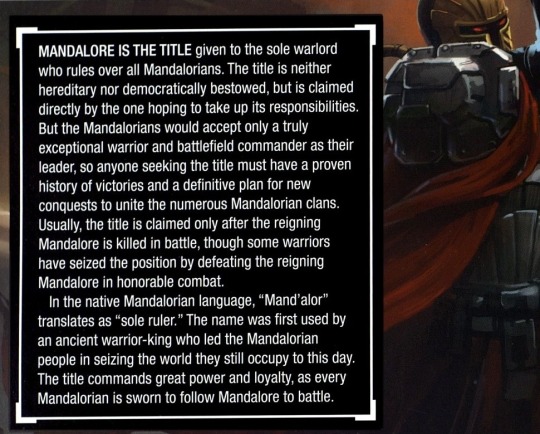
and summarized by Canderous Ordo: “When our leader falls in battle, the most worthy takes his place”. (Star Wars Miniatures)
Similar approach could be seen in regard to hierarchy between clans and its members. For example, Galaxy At War Sourcebook describes Taung society as “clan-based nomadic culture” in which ”veterans of successful battles are held in high regard, to such an extent that they are de facto leaders of their communities. Only the leader of all the Mandalorians, known simply as Mandalore, holds greater sway with the clans.”
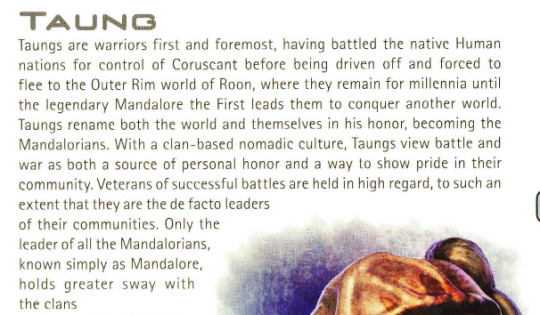
while SW:TOR Encyclopedia states “Although clans may have ties or rivalries with other clans, there is no formal hierarchy. All clan chieftains report directly to the Mandalore”.
(The lack of formal hierarchy wll change overtime, as some old and/or powerful mandalorian clans like Vizsla and Kryze turned into Houses. The sources so far did not provide enough data about inner workings of said Houses, although Sabine’s introduction in Rebels: Protectors of Concord Dawn [S02E13] as “I'm Clan Wren, House Vizsla” implies other, lesser(?) clans are subject to them. Similarly, House Kryze at some point became officially acknowledged as the Royal Family that ruled Mandalore before and during the Clone Wars. Simultaneously, the number of clans is not constant and limited, as sources provide examples of new clans formed during different eras.)
At the same time, the Mandalore, clan leaders and veterans - the broadly understood "ruling class" - may be challenged by anyone and according to the law, the honorable duel will officially settle the conflict[14]. This law apparently survived to modern times as could be seen in
Death Watch Manifesto: “to ensure we would be led by the most powerful, we decreed that any warrior could challenge the Secret Mandalore for leadership of Death Watch”

and The Clone Wars TV animated series when Maul challenged Pre Vizsla to a fight over control of Mandalore & Death Watch:
Almec: “Clearly you are powerful, but how can two of you overthrow Vizsla and his supporters?” Maul: “Vizsla is a soldier and, like every soldier, he is bound by honor. I will challenge him to single combat in front of his men. He will not deny me.” Almec: “Hmm. If you defeat him, according to the ancient laws of Mandalore, his soldiers will be honor-bound to follow you.” [TCW S05E15: Shades of Reason]
All of this implies that Mandalore and even the highly renewed veterans do not stand above the law - and maybe, ironically, are even more bound to follow it, as their honor is at stake.
Now, Ha’rangir clan is said to get away with dishonorable act during an official duel because of the religious connection and money and in all fairness, this speaks a lot about Mandalorians of that time. The roots of this corruption however reach the end of the Mandalorian Wars and the following decade(s) which brings me to another vital point. How exactly Ha’rangir clan got their fortune?
Lane Vizla described members of said clan as “old money with an even older name”. while Shae Vizla further explained:
Player: Clan Ha’rangir? Shae Vizla: I figured we’d see them around. Like I said before, they’re old money. Many clans got rich from plunder during the Mandalorian Wars generations ago. They want those days back, and Heta’s the answer.
If we agree that Ha’rangir clan got rich from plunder during the Mandalorian Wars, the clan dates to at least the last phase of Taung era (and Lane suggests the clan is even older than that). As much as it is true that Crusaders and Neo-Crusaders raided and robbed many planets, Taungs weren’t exactly focused on material wealth. Yes, they prized advanced technology and generally understood weapons were always at the top of list to steal, but money and similar goods? KotOR Campaign Guide states that “trade within Mandalorian communities is based on barter, with jewelry and precious metals used as portable commodities alongside weapons and armor” and that Mandalorians were familiar with galaxy currency however beside that one paragraph, the traditional culture didn’t seem to hold material goods other than an armor in any real regard, as only personal achievements allowed warrior to rise in the social hierarchy.

Thinking about this matter, KotOR tie-in materials allowed us to dwell into the Mandalorian mindset and majority if not all named Mandalorian characters showed no real concern over the money.
In KotOR: War, new recruits were provided with armor and weapons, warriors did not complain about living in harsh, frontline conditions even while raising children. Ko Sornell's advice to a newcomer (Zayne) was “find some wall to lean against. During invasions we sleep in armor. You'll get used to it” [KotOR:War #2]
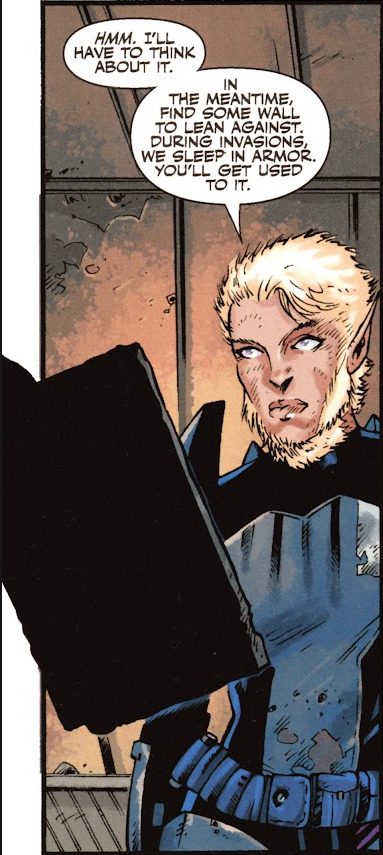
Another example comes from Interference short story taking place in early 3963 B.B.Y. When Mandalorians were faced with republic propaganda broadcasting on their communication frequency, taunting with luxury, even talking about how the Republic has “Real beds. Running water” in contrast to mandalorian camps and finally promising wealth:
And it is an offer. They say that Mandalorians deal with things in a Mandalorian way. Well, the same is true of the Republic. And what is the Republic at heart, if not first and foremost, a vehicle for the enrichment of all peoples? There isn't any reason at all why the forces of Mandalore can't have a seat at the table like anyone else. And so the offer is this: The Republic would welcome a cessation of hostilities with the Mando'ade. In return, the Senate would be willing to commit a share of all taxation from Republic planets and hyperspace lanes currently under Mandalorian occupation to go to the occupiers. That's right: the spoils of war, to stop the war. It is a fair price, and one that should more than satisfy all your requirements. With your victories in these weeks, your honor has been restored. The galaxy knows it. The Jedi did nothing to stop you; they know it. And you will have the prize -- part of the wealth of these stars, without having to continue to enforce your will on them. You'll be free to explore your options elsewhere, in directions away from the Republic -- and you'll be better funded to be able to do it. “
Ko Sornell reported to her superior, Cassus Fett, this:
Yes, Cassus, I responded already. I used the transmitter here on Zongorlu. I know I should have waited. Who is Koblus Sornell, anyway? Just a warrior. A signals expert, but a warrior. A Mandalorian warrior… ... and as a Mandalorian warrior, their "choice" was really no choice at all. I spoke for all of us: Their "bargain" was ridiculous. Think about it: They could have a glorious battle, a true measure of what we're worth. That's a bargain. Instead, they're trying to choose -- a bribe? To buy peace like a peasant at a shop? All it costs is whatever guts they ever had. And they thought we might agree to it! Whatever gave them that idea? Just like with this "Captain Goodvalor" business. Pretending to be the victor of great battles -- that's insulting enough all on its own. But big talk about what they can do, how big their forces are? Lies about people leaving our side? Did they really think any true Mandalorian would listen? Do they really fear us so little?
Cassus Fett himself showed little care for wealth, as can be seen in short interaction with Gromar [KotOR #23].

"--you listen to Cassus Fett and your son's sons will have nothing to do -- because you'll have concquered everything!"
Cassus admitted Mandalorians didn’t make full use of the resources of the conquered lands because they rarely stayed in one place for long (the curse of nomad life, as he called it) however he did not promise wealth to his subordinate but that Mandalorians are gonna conquer the whole galaxy leaving nothing for new generations.
Canderous Ordo mentioned in some of his game dialogues the fortunes (wealth):
Canderous: You want to hear tales of my exploits? Of the wars I've seen and fought, the enemies I've seen die by my hand? Heh, sure, I'll humor you. My name's Canderous of the Mandalorian clan Ordo. I've been fighting across the galaxy for 40 of your years. For my people it's the honor and glory of battle that rules us. It's through combat that we prove our worth, gain renown and make our fortunes. [KotOR game]
or
Mandalore: The Republic thinks my people are dead, scattered. They are wrong. You should have destroyed us when you had the chance. As long as one Mandalorian lives, we will survive. Our honor, fortunes, and lives revolve around battle. From our earliest history, this has been our way, as it will be, always. [KotOR 2 game]
however other tales made it clear money itself did not have the same value as armor, weapon and basilisk droids, as losing those three (cultural) things hurted defeated Mandalorians the most:
Canderous: The war we had with the Republic was supposed to be the most glorious battle of our history, but… it was a very costly one. I guess we didn't think of how much we could lose in it. [...] There weren't many of us left after that last battle. Mandalore himself was killed at the hands of the Jedi Revan. The best of us could not defeat him! After that last battle, those of us that survived were stripped of our weapons, our armor, and our Basilisks. Revan's forces destroyed them while we were forced to watch. Those who hadn't fled earlier were left with nothing to call their own: no weapons, no armor… only the honor of having fought in the battle we just lost. For many this was not enough. While the rest of us were sent into exile on the Outer Rim, they tried to relive the old days – raiding worlds. They're nothing more than bandits now. [KotOR game]
Canderous specifically said “Those who hadn't fled earlier were left with nothing to call their own: no weapons, no armor” so clearly, the “warrior equipment” is the wealth that Mandalorians cared for, not credits or other material luxuries. Similarly approach was seen a decade later in Mandalorian Camp on Dxun:
That idiot Kumus will be working off his shame for the rest of his days. Equipment eaten by cannoks - it would have been better if he'd let the jungle take him. [KotOR II]
However, as Canderous mentioned, after the Mandalorian Wars, this mindset changed in favor of money. Some Mandalorians turned into mercenaries, some kept raiding worlds, some turned into bandits attacking simple farmers. This sentiment was repeat by Veela from The Old Republic: Revan:
“When Revan hid Mandalore`s Mask, most of our people scattered in disgrace. But some of us refused to give up. We stayed behind to look for what was lost instead of running off to become mercenaries and hired thugs.”
Similar statements comes from History of the Mandalorians:
“Following their failed campaign, the Crusaders found a new object of worship -- the almighty credits. Decimated and embittered, the surviving Mandalorian warriors turned ruthlessly mercenary in order to survive. Informally called the Mandalorian Merc, these individuals hired out their lethal talents to the highest bidders without regard to silly notions like justice, morals, and honor.”
So, did members of Ha’rangir Clan enriched themselves during the Mandalorian Wars, as Shae Vizla said, or did they get their fortune from post-war raids, as Codex Entry suggests? This is an important question in context: how old the clan truly is? Because there is a chance that the clan's origin grew into myth over the time, the same as their “cultural” role.
I mean, Canderous and Veela of clan Ordo were eyewitnesses of change happening in their society while Shae Vizla and contemporary Mandalorians may only rely on knowledge passed down to them by their predecessors. Considering how Mandalorian people were broken and divided after war, it is quite possible that a lot of historical knowledge was lost or misrepresented, even on purpose.
At the same time, there were attempts to bring back Mandalorians to their honorable ways. The best known example is Canderous Ordo, who for his efforts earned the title Mandalore the Preserver. In KotOR II: Sith Lords, he said “Many Mandalorians have fallen from the path of honor and are now no more than common mercenaries. But that is changing” yet despite Ordo’s best intentions, the unity of Mandalorian clans is much more fragile than what it was under Taung leadership. But if Canderous could dedicate his life to rebuilding Mandalorian society under his banner (against Sith as Revan wanted), then logically thinking there could be more reformators like him. Which is another possibility to see Kad Ha’rangir. Not as a literal deity but actual historical figure who could renamed himself in honor of the warrior god[15], either presenting himself as “chosen” warrior / tool or maybe even as the god’s prophet of some sort or whose fame (interpretation of warrior culture) overtime grew into a myth that benefited the entire clan. TOR game presented us with Mandalorians such as Kur Ha’rangir and Arla Ha’rangir so Kad Ha’rangir easily could be a full name of real person who started the Ha’rangir family in the first place and whose person at some point merged into one with the mythical god in mandalorian collective consciousness. This brings back the question - did Taung truly knew Kad Ha’rangir under this exact name and not just, for example, simply as Ha’rangir?
As I hopefully established in previous parts, swords weren’t the traditional Mandalorian (Taung) weapon while the Kad Ha’rangir name, for the first time showed in in-universe source coexisting with the events taking place approximately 300 years after Taung died out. This is of course matter of game mechanics, but The Old Republic presents on screen
Mandalorian characters using commonly swords
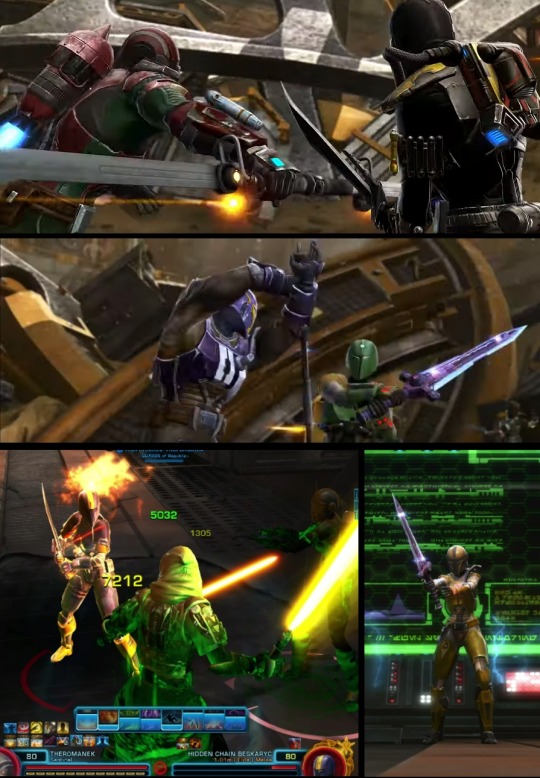
lore entries like Mandalorian Relics: The Final Blade of Dunesa Rul (x)

[...] Rul's creations, prized within the Mandalorians, were often handed down from one clan leader to the next, but demand for new work was overwhelming. Rul was killed in an explosion during an altercation between Clan Mettir and Clan Ironstone, who sought to lay claim to a masterwork weapon--a durasteel dagger--he had created. Both clans were hunted down and destroyed in retaliation for the grievous loss. The dagger itself was never found.
Even the official duel between Mandalore the Avenger and Field Marshal Kol Heta was done with ceremonial swords
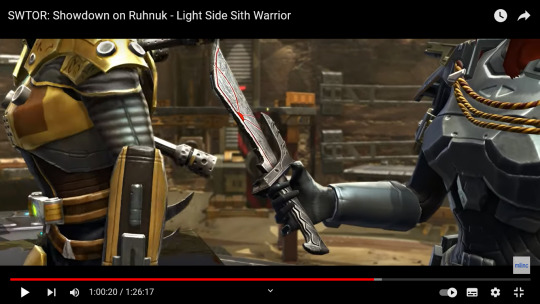
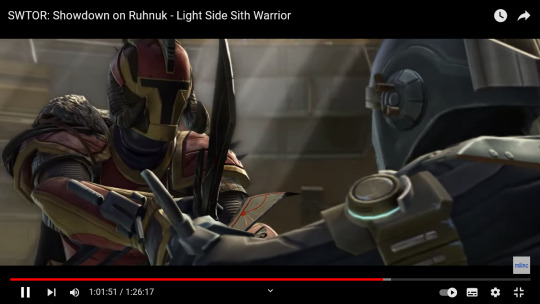
while so far the only axes I noticed are Gamorrean made (x)

and vibro axe (x)
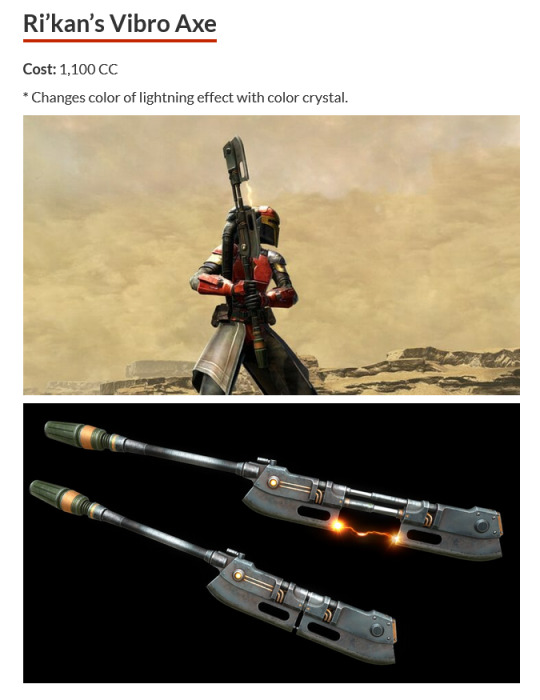
and none of those are even close in shape to traditional Mandalorian (Taung) ones. This kind of weapon seems to have lost its importance in the favor of swords/sabers, so if Kad Ha’rangir was a historical figure who either claimed or was hailed by others as descendant of an old god, he could be also a reason (impulse) for the switch from axes to swords. As in, Mandalorians considered him to have divine connections - or even be the embodiment of divine will - and started preferring swords as a symbol of their renewed faith to honor god. The mentioned in Codex Entry “a bloody expansion called "Ha'rangir's Path" in the latter half of 3732 BBY” fits well in that assumption and even could be treated as the approximate date of “religious (weapon) reformation”.
Like it was already mentioned, the unity between Mandalorian (human dominated) clans is a much more fragile matter than what we know about the Mandalorian society under leadership of the last two Taung rulers - the Indomitable and Ultimate. The conflict between old fashioned warriors and mercenaries started after Mandalorian Wars and will last to modern days however in The Old Republic game it took a surprising shape. The current conflict has divided Mandalorians into supporters of Mandalore the Avenger (Shae Vizsla, a former bounty hunter herself) and Field Marshal Kol Heta (leader of Hidden Chain) who wants to bring Mandalorians to their warrior roots and regain the lost independence. The surprising part of this conflict is that both sides acknowledged the need to preserve material artifacts to keep their culture intact and give people tangible connection to their history and past deeds.
And so TOR game included:
The Importance of Mandalorian Relics codex Lore Entry: For many Mandalorians, relics are an important touchstone to connect with their long and fractured history. The cultural identity of this clan-based group is centered around conflict and combat, so a chaotic history of war is expected. While grounded in a common creed and code, those who wish to understand and honor past achievements will look to items that gained significance during a specific event, battle, or because they were wielded by a person of great renown. These relics can become symbols of the core tenants of the Mandalorian beliefs; a physical embodiment of a philosophy that is rooted in the most primitive of contests between creatures of flesh and blood. Perhaps more than the leaders before her, Mandalore the Avenger recognized the importance of these relics in helping to unify the clans with a history they could see and touch, and so began to collect and house important artifacts from the past in order to smooth the path to the future.
or
Seeker's Vigil codex: Lore Entry: This heavily-guarded space-faring vault serves as a monument to what the Ash'ad consider the glories of Mandalorian culture. Within these fortified walls lay the history of conquest, raiding, victory, loss, and struggle that characterize a true Mandalorian warrior's existence. There are so many tomes in the libraries that the archivists have lost count. Tableaus and frescoes line the hallways, depicting Mandalorian battles whose names may be forgotten, but are still part of their history. It would take multiple lifetimes to even begin to uncover all of the knowledge hoarded within, and those that call this vessel home will ensure that if the Mandalorian way ever falters, they will be there to teach new generations what it really means to hunt and live the life of a raider.
or
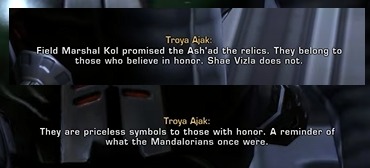
Troya Ajak: "Field Marshal Kol promised the Ash'ad the relics. They belong to those who believe in honor. Shae Vizla does not." "They are priceless symbols to those with honor. A reminder of what the Mandalorians once were."
The importance of relics collected by Shae Vizla’s supporters and Kol Heta’s Hidden Chain could also lead to a renewal of religion - however how true to original faith it was, is of course up to debate.
During Spirit of Vengeance Arc, the player was forced to walk through enemy ships belonging to Mandalorian clans such as Varad and Ash’ad. Here, clearly the various items

are treated differently than what we could see in frames presenting Shea Vizsla’s or Kol Heta’s meeting room.


The skulls and fire flames reminds me mentioned in previous part (#4) details from Cassus Fett and Demagol’s workplaces and may be a continuation of the same magical-religious traditions. What stands out the most is presents of altars and/or place of sacrifice.

On one of the ships, there was even a great statue that resembles Mandalore the Ultimate
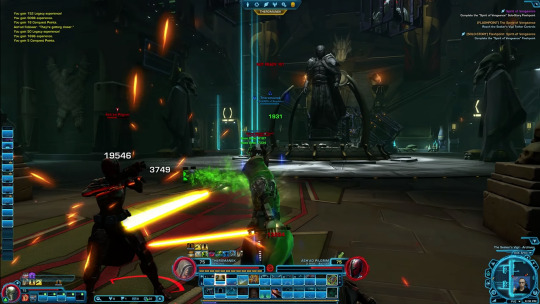
but could actually represent a god (Destructor maybe?), considering all the bones - sacrifices? - piled up around.
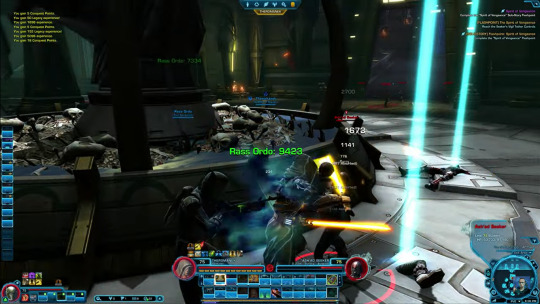
This is one of the better documented examples of likely religious practice among warriors.
In general, The Old Republic game is so far the one major source providing the most direct information about Kad Ha’rangir in relation to the events taking place, while ��Death Watch Manifesto” [Bounty Hunter Code] and “Industry. Honor. Savagery: Shaping the Mandalorian Soul” [The Essential Guide to Warfare] were written in distant modern times. At the same time, the game did not include the traditional Mandalorian (Taung) mythosaur axe, as in this era the swords are the most common weapon alongside blasters. Which leads me to believe that Kad Ha’rangir may be a side effect of religious renewal that happened decades after the original Mandalorians died out, as religion in itself is a very good carrier of culture and binder for a broken community. As post-KotOR sources provided, Mandalorian people were divided and in need of symbol(s) under which they could unite - a need recognized by both Shae Vizsla and Kol Heta. Thus the founder of the Ha'rangir clan could become one of such symbols and his achievements and/or charisma at some point grew into a myth affecting Mandalorian people’s perception of original (Taung) gods. As humans dominated warrior society, it makes sense that some aspects of older culture took different shapes to fulfill their needs.
My final conclusion (theory) is that the “Destructor” was part of Taung mythology albeit there was no connection between warrior god and sword/sabers - if anything, the deity’s attribute was an axe which is why the weapon was held in such great regard. However once Taung died out leaving remnants of Mandalorians scattered and broken, some warriors took upon themselves to resurrect their culture. Ordo Canderous tried to unite Mandalorians under his banner (against Sith), while some time later, Kad Ha’rangir, as a historical figure, brought changes - religious reformation? - that influenced perception of old mythology and somehow, maybe in honor of his name, swords for good replaced mythosaur axes. Later, Tarre Vizsla - the first Mandalorian Jedi - created darksaber that became another important relic that affected his people’s spiritual and material culture.
The modern authors based their knowledge in majority on sources that were passed down to their era and could over time become distorted or their original meaning has completely lost. Which could explain the discrepancies between what sources showed and the knowledge of the (in-universe) authors.
SIDENOTES:
[12] Lane said this story about her brother's death:

Years ago, Kur Ha'rangir challenged my brother to a duel. Over some perceived slight against his famous name. Kur used nothing but underhanded tricks-like he does with everything else, There was no honor in the way he fought... He killed by brother... and no one called out Kur's deception. Typical, for a Ha'rangir.
[13] Another example implying Taungs & Neo-Crusaders had a special respect for (dead) ancestors/family members is the specific greeting used by Mandalore the Ultimate during meeting with Arkanian leader

... and all honor to your family's dead [KotOR #20]
And Ko Sornell while adressing Cassus Fett (one of the closest advisors of Mandalore):
Su'cuy, Cassus Fett, and all honor to your family's dead. [KotOR: Interference short story]
[14] The honor duel does not exactly need to end with the loser's death, as Ulic spared Mandalore the Indomitable’s life but as sources show, death was an usual occurrence. Frankly, the example of Canderous Ordo vs Jagi implies that once the challenge was issued there was no way to revoke it. Even though Jagi learned that his former commander’s action were not motivated by selfishness (glory-seeking) as he assumed for years and accepted his accusation turned out to be false and unfair, the man committed suicide to clean his own name:
Canderous: I saw a chance and had to take it. It ended the battle quicker than we would have otherwise, and many of our warriors may have died. Mandalore taught us that opportunism and flexibility in battle were to be admired. You may contradict me, but do you contradict him as well? Jagi: No! I... I... I see that I have been wrong. I have not been true to the teachings of Mandalore. You were right. I was wrong to question your honor. But I must now cleanse mine with my life.

Jagi didn't haveto fight Canderous, and you tried to persuade him not to. The Mandalorian sense of honor, however, would not let him live having done what he has. Jagi took his own life in the Dune Sea. This has deeply affected Candeour. [KotOR game]
[15] Similar like clone trooper KADDAK used the name of Mandalorian god in Darth Vader: Cry of the Shadow
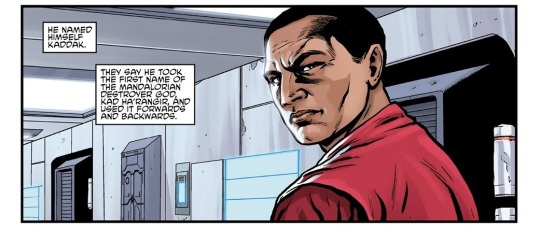
He named himself Kaddak. They say he took the first name of the Mandalorian Destroyer God, Kad Ha'rangir, and used it forwards and backwards.
#star wars#mandalorians#mandalorian culture#Cienie’s take on Mandalorian Culture#kad ha'rangir#taungs#to my regret i couldn't use all screenshots and frames I had collected due to picture limits lol#i finally finished it#i strongly believe that taungs knew the god of destruction but rather under simple name of ha'rangir#while the “kad” part was added over time#and started the era of sword / saber and its special role in mandalorian culture & religion#mandalorian culture is pretty dynamic one when it comes to changes and evolutions or rather revolutions
17 notes
·
View notes